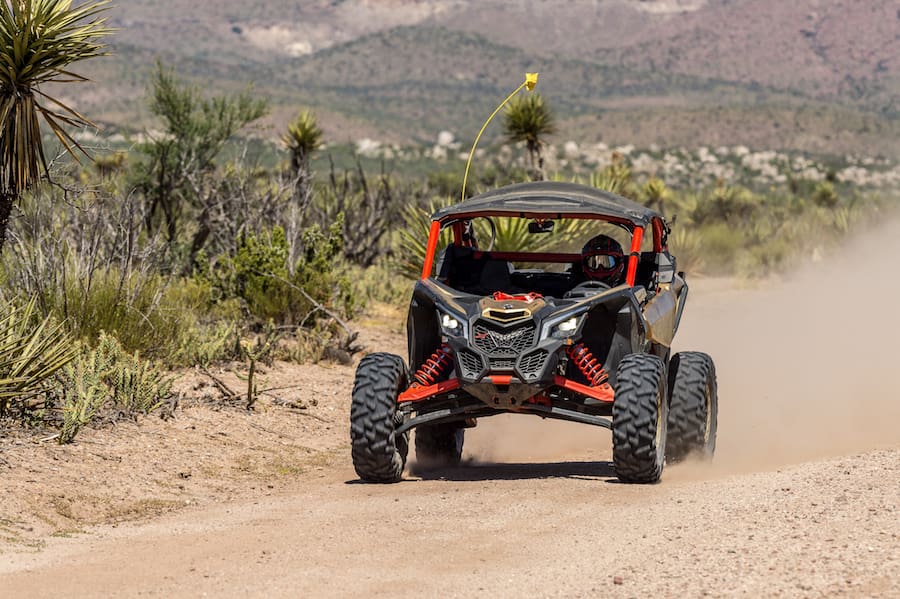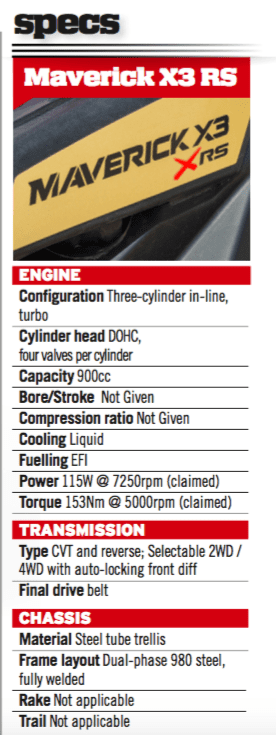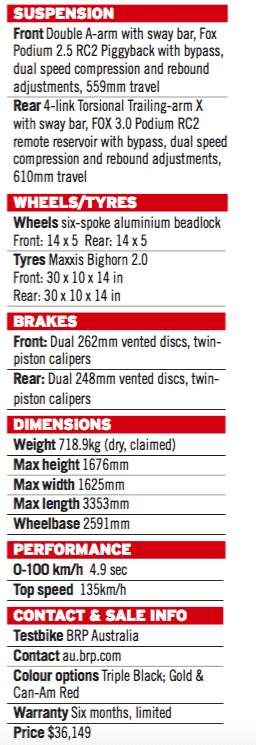The side-by-SIDE buggy market is massive in the States and it’s set to burgeon here too. All the blokes who bought dirtbikes in the 90s and rooted their knees, shoulders, hips? They’re getting into buggies now, sometimes as pilots, sometimes as passengers. In the US, side-by-sides fitted with spine-boards are often used as casualty evacuation vehicles in areas where helicopter access is limited, like forests and canyons. Many emergency response departments and sheriffs in remote areas have vehicles to take paramedics to patients – and get patients out to road or air ambulances.
Side-by-sides are all about suspension travel and in Can-Am’s top of the range Maverick X3 RS, that’s 610mm at the back and 559mm at the front, with 381mm of clearance. Never mind the terrain, the big FOX 3.0 canisters deliver a ride that won’t shake loose a single filling. Even in the base model X3 DS, there’s 508mm of travel all round and 356mm of clearance.

The rear-mounted 115kW/153Nm turbocharged and intercooled 900cc engine has a little turbo lag, but even when fitted with the optional Yoshimura pipes it just sounds like a snowmobile on dirt. After a full day of testing, this lack of noise was no bad thing.
The Rotax ACE 900 engine has already been proven in Spark and Ski Doo machines from BRP. Different, larger models exist too, such as the ACE 1330, so expect tuners to start swapping cylinders and adding BRP’s own supercharger to the X3. The stock turbo is built in-house by Rotax.
The Maverick uses a Constantly Variable Transmission (CVT) and its cooling and engine air intakes are mounted high, nearly at head height – so if the driver can still breathe, the vehicle will still run.
Things become very real very fast when someone points you at a dirt road where you’d think twice about riding a trail bike and tells you to go for it … for the next 250km.

Never before has a top speed of 135 km/h felt so fast; learning the Maverick’s capabilities is as much about maintaining constant speed as it is about reading the track – or lack of it – that you’re on.
The Maverick has no key. Instead, a chipped plug snaps into place and then you can press the start button. A ‘learner’ plug will also be available that limits top speed.
The other area Can-Am has nailed is the power steering. You just don’t get tired. The company’s Tri-Mode dynamic power steering system offers three levels of assistance, but it’s hard to tell the difference between them.

Interesting factoid: the Maverick’s seats are made by the same company that makes seats for Ferrari. They’re adjustable through a 150mm range, but only with tools.
The sheer ability of the Maverick is extraordinary. The only time its limits were tested was when braking too late into corners, and that was sheer operator error, not a machinery fail. The Maverick dares you to push it harder and harder, and the more you drive the more you learn its abilities are far in excess of yours.

Reliable, fast, absolutely go-anywhere … if you could register one on the road you’d have the ultimate all-terrain vehicle and they would be everywhere. Options – in the US at least – include MTX audio, a Rugged Radios intercom and iPad mount. Fuel capacity is a class-leading 40 litres, the tank sitting above the passenger’s feet.
Can-Am has three models of Maverick but in Australia we’ll only get the top two, with the X3 DS at $33,149 and the X3 RS coming in at $36,149. That extra three grand gives you a monster list of additional options, none that you truly need, but all that you want.
Can-Am hasn’t announced a four-seat version of the X3 – yet. But it did say there’ll be a new Can-Am UTV released every six months until 2020.
Even if you’ll never need to move a banged-up dirtbike rider, the Maverick X3 is a highly desireable machine and a helluva vehicle to own – because if an earthquake ripped up all the roads, X3 drivers would be able to enjoy every second of the disaster.
By Matt o’Malley
Photography BRP













